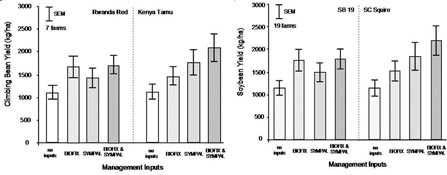At the start of Phase II, a model for indirect dissemination is being formulated. Established Action Site partners are maintained and six new development partners willing to disseminate recommended N2Africa technologies have been identified.
To achieve a sustainable input supply, input suppliers (MEA, SeedCo) are linked to agrodealer associations (KENADA) and the seasonal orders of large farmer associations including the KESOFA. Commercialization of BNF technologies is led by MEA Ltd, producers of BIOFIX inoculants and Sympal fertilizer. Marketing and legume product development is conducted in conjunction with UNIDO and its three recently developed legume processing factories, and with Promasidor, a top-end buyer of soyabean. Other key partners include the Kenya Soybean Farmers Association, SeedCo, the Western Chapter of the Kenya Agrodealer Association (KENADA) and the recently founded Soybean Stakeholder Working Group.
BNF technology testing and N2Africa led dissemination led technology continued during the 2013-2014 short rains growing season. In this season, 3476 households received a BNF technology package, bringing the number of on-farm technology tests since project inception to 37,464 households (99.9% of the initial outreach target). In addition, trials were established to refine field management using improved legume varieties of soyabean (SB19 and SC Squire) and climbing bean (Kenya Tamu and Rwanda Red) grown in conjunction with Sympal fertilizer and BIOFIX inoculant following current best practice (Figure 1).
|
Figure 1: Yield of two climbing bean (left) and soyabean (right) varieties in response to inoculant and fertilizer during the 2013-2014 short rain growing season in west Kenya. |
For soyabean, Squire outperformed SB19 when both fertilizer and inoculants were applied, producing 2399 (±348) kg grain ha-1. Similar trends were noted for common bean with Tamu outperforming Rwanda Red (2165 kg ha-1 ±664). Soyabean performed well in the Lake Basin and Midlands, but less so in the Upper Midlands (>1500 masl). |
From 6 month country report by Paul Woomer (compiled by Greta van den Brand).

